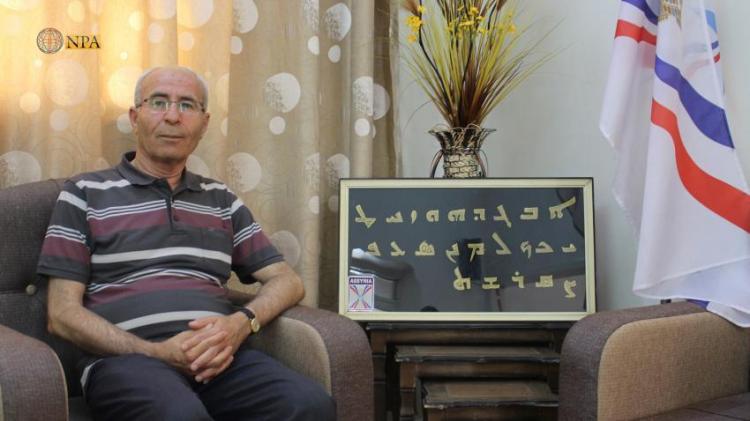Syriac language.. official in NE Syria and “ritual” in Damascus government
Qamishli – North-Press Agency – Reem Shamoun
Autonomous Administration in north and eastern Syria considers the Syriac language as an official language in its areas of control alongside the Kurdish and Arabic languages, while Damascus government deals with it as a “ritual language only”, according to Gabriel Moushe, a former member and founder of Niseibin Association for Syriac Authors.
Syriac language is one of the oldest languages in the world, extended from ancient Babylonian-Akkadian and Aramaic languages. It has one of the oldest alphabets in the world.
Its history
The language dates back to the first millennium BC and spread in the Levant and Mesopotamia to Persia and Egypt, as many historical evidences which indicate the ancientness of this language, were found.
Gabriel Moushe, the head of the Democratic Assyrian Organization (ADO) said that there are many countries and large universities in the world, such as Oxford, Cambridge, Al-Azhar University, Cairo and others, interested in studying and teaching the Syriac language alongside Greek and Hebrew, in order to understand many ancient facts, whether historical, religious or theological. Noting that those who learn it in particular, are interested in matters of history, excavation and archeology; “because a lot of documents and manuscripts were written in these languages.”

Efforts to preserve it
Moushe stated that the largest gathering of Syriac speakers, in its eastern and western dialects, is located specifically in the Syrian Al-Jazira and Qamishli. Church sought to preserve the Syriac language through holding courses in summer and through Sunday schools, by teaching children in order to do prayers and religious rites.
The main reason that the Syrian government approved to teach this language within private schools of churches, was because it is purely ritualistic, as Moushe said.
Recently, Niseibin Association of Syriac Authors has issued modern and developed curricula that have been circulated to Syriac schools of the churches in order to be taught , which contributed to spreading and teaching the formal Syriac language more.
As for the spoken language, Moushe said that Syriac songs and folklore had served much in spreading and continuity.
At present time, with the development of technology, Gabriel Moushe pointed to new methods followed by some institutions in teaching the Syriac language through smart devices’ applications, where the Syriac Assyrian community in diaspora depend on to teach their children their mother tongue.
Curriculum
Eng. Galenos Issa, co-director of Olaf Tao Foundation for preparation and graduation of Syriac teachers, and preparation of Syriac language curricula, said that they have recently completed the setting and writing of curricula for primary and secondary schools in Syriac language, and that they have begun with the work on the new modified version.
Moreover, Issa pointed out that the objective of these curricula is to teach children the first three grades in their mother tongue, then add a secondary language from grade 4 till high school.
As for the differences between Syriac curricula and the ones of the Syrian government, Issa explained that they present the history of Syriacs as they are, not as others want, by “Arabization of Syriacs and considering them as Arab tribes from the Arabian Peninsula, as mentioned in the history book of the Syrian government curriculum.” As he said.
Regarding parents’ acceptance of the curricula prepared, Issa explained that the refusal of some of the Syriac people in Qamishli to the curriculum, is due to information has been spread among them as a curriculum without a future and no one will admit the license granted by studying it.

It is noteworthy that Olfa Tao Foundation began training and preparation of teachers of all components on teaching Syriac curriculum in Autonomous Administration schools since 2016. Two books were applied in Church’s private schools, the Syriac language book and Music book, last year.
The language of “Ruha” is the formal Syriac language that is adopted by all Eastern Churches. While the dialects are multiple, such as the dialect of “Tor Abdin” and it is called the Western dialect, while the eastern dialect is called “Sorath” and it is spoken by the people of Al-Khabour and the people of Iraq in Nineveh Plain. The Syriac alphabet consists of 22 characters, but it has 28 vowels.

